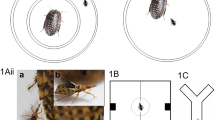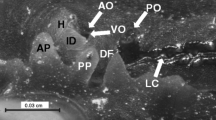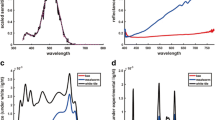Abstract
The carabid beetlePasimachus subsulcatus is an abundant ground-dwelling insect in west central Florida that exudes a powerful mucous membrane irritant when disturbed. This secretion can be sprayed over 10 cm from the abdominal tip. The southeastern five-lined skink,Eumeces inexpectatus, is an abundant insectivorous lizard sympatric withPasimachus. We assessed the availability ofPasimachus toEumeces and found it to be within the foraging microenvironment of the lizard. Analysis ofEumeces gut contents and field feeding trials indicate thatPasimachus are not ingested by the lizard, yet arthropods of comparable size and exoskeletal thickness are ingested. The movement response ofEumeces to isolatedPasimachus secretion constituents, conducted in a modified Y-maze laboratory experiment, was used to assess the repellent capabilities of the secretion.Eumeces are consistently repelled byPasimachus secretion constituents, indicating that the beetle is protected chemically from the lizard.
Similar content being viewed by others
References
Bissinger, B.E., andSimon, C.A. 1979. Comparison of tongue extrusions in representatives of six families of lizards.J. Herpetol. 13:133–139.
Blum, M.S. 1982. Chemical Defenses of Arthropods. Academic Press, New York.
Burghardt, G.M. 1966. Stimulus control of the prey attack response in naive garter snakes.Psychol. Sci. 4:37–38.
Burghardt, G.M. 1973. Chemical release of prey attack: Extension to naive newly hatched lizards,Eumeces fasciatus.Copeia 1973:178–181.
Camp, C.L.1923. Classification of the lizards.Bull. Am. Mus. Nat. Hist. 48:289–481.
Carrel, J.E., andEisner, T. 1984. Spider sedation induced by defensive chemicals of millipede prey.Proc. Nad. Acad. Sci. U.S.A. 81:806–810.
Cooper, W.E. 1981. Visual guidance of predatory attack by a scincid lizard,Eumeces laticeps.Anim. Behav. 29:1126–1136.
Cooper, W.E., andVitt, L.J.1986a. Thermal dependence of tongue-flicking and comments on use of tongue-flicking as an index of squamate behavior.Ethology 71:177–186.
Cooper, W.E., andVitt, L.J. 1986b. Tracking of female conspecific odor trails by male broad-headed skinks (Eumeces laticeps).Ethology 71:242–248.
Cooper, W.E., andVitt, L.J. 1987. Interspecific aggression in lizards of the scincid genusEumeces: Chemical detection of conspecific sexual competitors.Herpetologica 43(1):7–14.
De Fazio, A., Simon, C.A., Middendorf, G.A., andRomano, D. 1977. Iguanid substrate licking: A response to novel situations inSceloporus jarrovi.Copeia 1977:706–709.
Eisner, T. 1966. Defensive spray of a phasmatid insect.Science 148:966–968.
Eisner, T. 1970. Chemical defense against predation in arthropods, pp. 145–172,in E. Sondheimer and J.B. Simeone (eds.). Chemical Ecology. Academic Press, New York.
Eisner, T., andDean, J. 1976. Ploy and counterploy in predator-prey interactions: Orb-weaving spiders versus bombardier beetles.Proc. Natl. Acad. Sci. U.S.A. 73:1365–1367.
Eisner, T., andMeinwald, J. 1966. Defensive secretions of arthropods.Science 153:1341–1350.
Eisner, T., Meinwald, J., Monro, A., andGhent, R. 1961. Defense mechanisms of arthropods- I. The composition and function of the spray of the whipscorpion,Mastigoproctus giganteus (Lucas) (Arachnida, Pedipalpida),J. Insect Physiol. 6:272–298.
Eisner, T., Hurst, J., andMeinwald, J. 1963a. Defensive mechanisms of arthropods, XI. The structure, function, and phenolic secretion of a chordeumoid millipede and a carabid beetle.Psyche 70:94–116.
Eisner, T., Switenhbank, C., andMeinwald, J. 1963b. Defensive mechanisms of arthropods III. Secretion of salicylaldehyde by a carabid beetle.Ann. Entomol, Soc. Am. 56:37–41.
Eisner, T., Kriston, L., andAneshansley, D.J. 1976. Defensive behavior of a termite (Nasuti-termes exitiosus).Behav. Ecol. Sociobiol. 1:83–125.
Eisner, T., Wiemer, D.F., Haynes, L.W., andMeinwald, J. 1978. Lucibufagins: Defensive steroids from the firefliesPhotinus ignitus andP. marginellus (Coleoptera: Lampyridae).Proc. Natl. Acad. Sci. U.S.A. 75:905–908.
Eisner, T., Hill, D., Goetz, M., Jain, S., Alsop, D., Camazine, S., andMeinwald, J. 1981. Antifeedant action of z-dihydromatricaria acid from soldier beetles (Chauliognathus spp.).J. Chem. Ecol. 7:1149–1158.
Fitch, H.S. 1954. Life history and ecology of the five-lined skink,Eumeces fasciatus.Univ. Kans. Pub. Mus. Nat. Hist. 8:1–156.
Forsyth, D.J. 1972. The structure of pygidial defense glands of Carabidae.Trans. Zool. Soc. London 32:249–309.
Jefson, M., Meinwald, J., Nowicki, S., Hicks, K., andEisner, T. 1983. Chemical defense of a rove beetle.J. Chem. Ecol. 9:159–180.
Jones, T.H., Conner, W.E., Meinwald, J., Eisner, H.E., andEisner, T. 1976. Benzoyl cyanide and mandelonitrile in the cyanogenetic secretion of a centipede.J. Chem. Ecol. 2:421–429.
Loop, M.S., andScovile, S.A. 1972. Responses of newbornEumeces inexpectatus to prey object extracts.Herpetologica 28:254–256.
McCoY, E.D. 1987. The ground-dwelling beetles of periodically burned plots of sandhill.Fl. Entomol. 70(l):31–39.
Morrow, P.A., Bellas, T.E., andEisner, T. 1976. Eucalyptus oils in the defensive oral discharge of Australian sawfly larvae.Oecologia 24:193–206.
Mushinsky, H.R. 1985. Fire and the Florida sandhill herpetofaunal community: With special attention to responses ofCnemidophorus sexlineatus.Herpetologica 41:333–342.
Nicoletto, P.F. 1985. The relative roles of vision and olfaction in prey detection by the ground skink,Scincella lateralis.J. Herpetol. 19(3):411–415.
Simon, C.A. 1983. A review of lizard chemoreception, pp. 119–133,in R.B. Huey, E.R. Pianka, and T.W. Schoener (eds.). Lizard Ecology: Studies of a Model Organism. Harvard University Press, Cambridge, Massachusetts.
Smolanoff, J., Kluge, A.F., Meinwald, J., Mcphail, A., Miller, R.W., Hicks, K., andEisner, T. 1975. A novel terpenoid insect repellent produced by a millipede.Science 188:734–736.
Sokal, R.R., andRohlf, F.J. 1981. Biometry. W.H. Freeman, San Francisco, pp. 704–711.
Vitt, L.J., andCooper, W.E., Jr. 1986. Foraging and diet of a diurnal predator on hidden prey.J. Herpetol. 20:408–415.
Vogel, P., andBrockhusen-Holzer, F. Von. 1984. Ants as prey of juvenileAnolis lineatopus (Rept, Iguanidae) in prey choice experiments.Z. Tierpsychol. 65:66–76.
Author information
Authors and Affiliations
Rights and permissions
About this article
Cite this article
Witz, B.W., Mushinsky, H.R. Pygidial secretions ofPasimachus subsulcatus (Coleoptera: Carabidae) deter predation byEumeces inexpectatus (Squamata: Scincidae). J Chem Ecol 15, 1033–1044 (1989). https://doi.org/10.1007/BF01015197
Issue Date:
DOI: https://doi.org/10.1007/BF01015197




